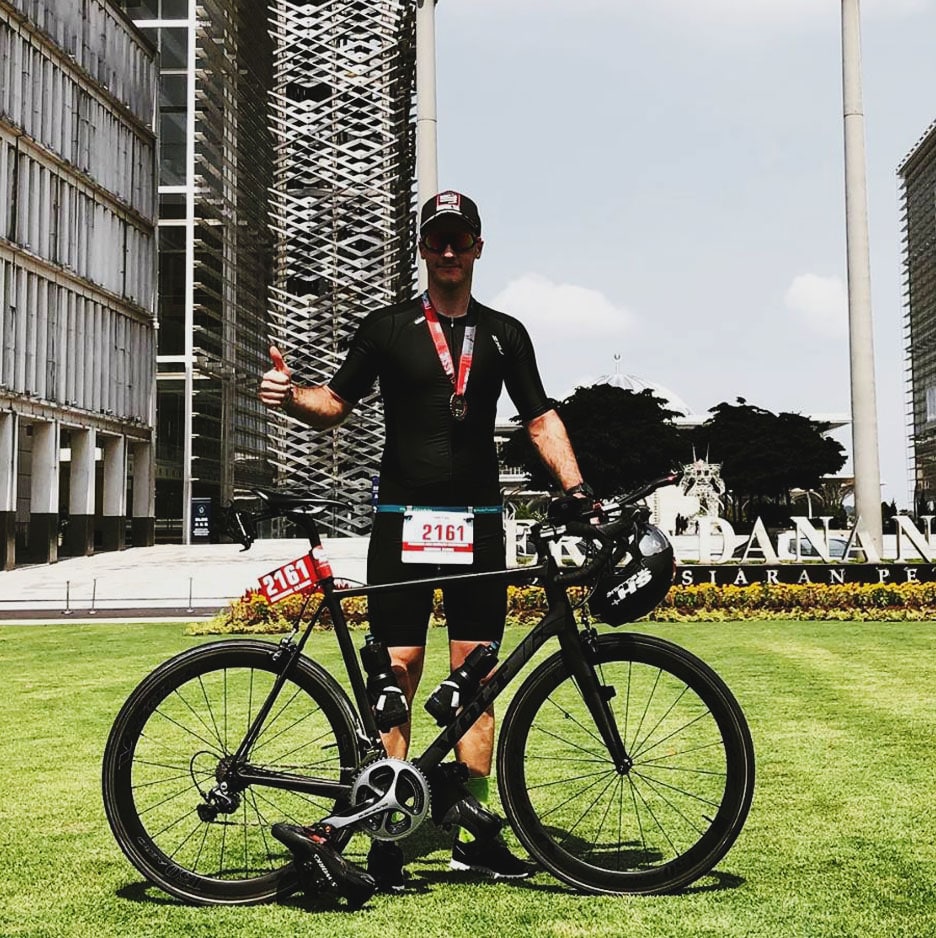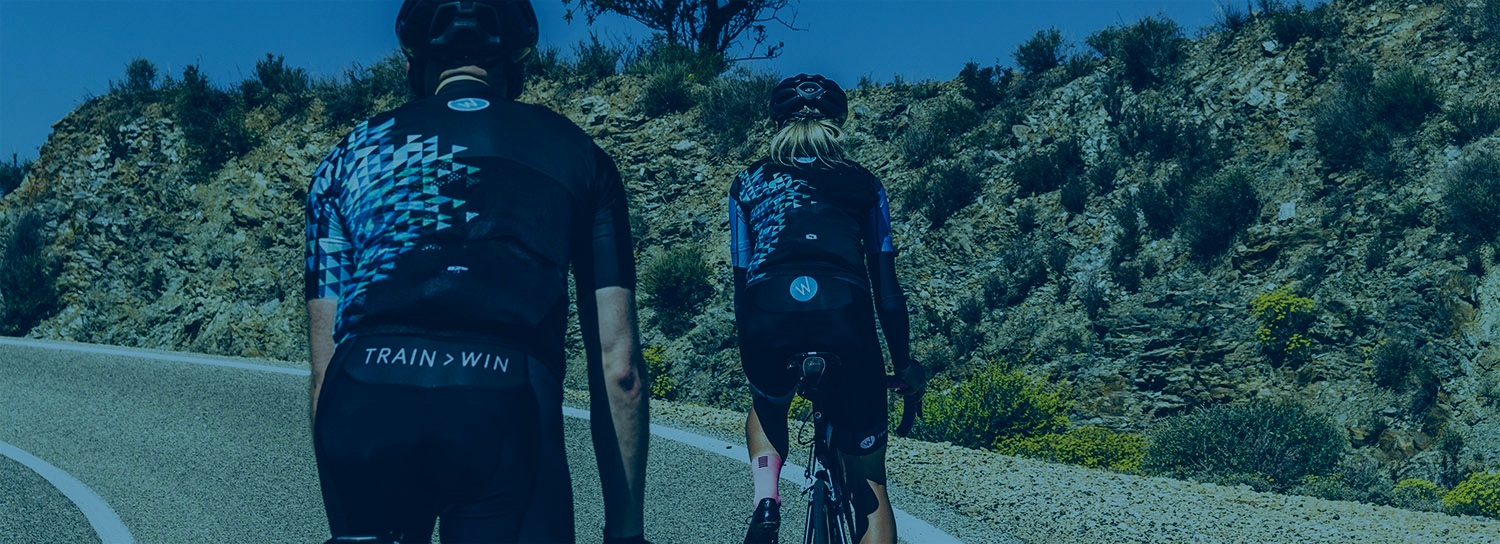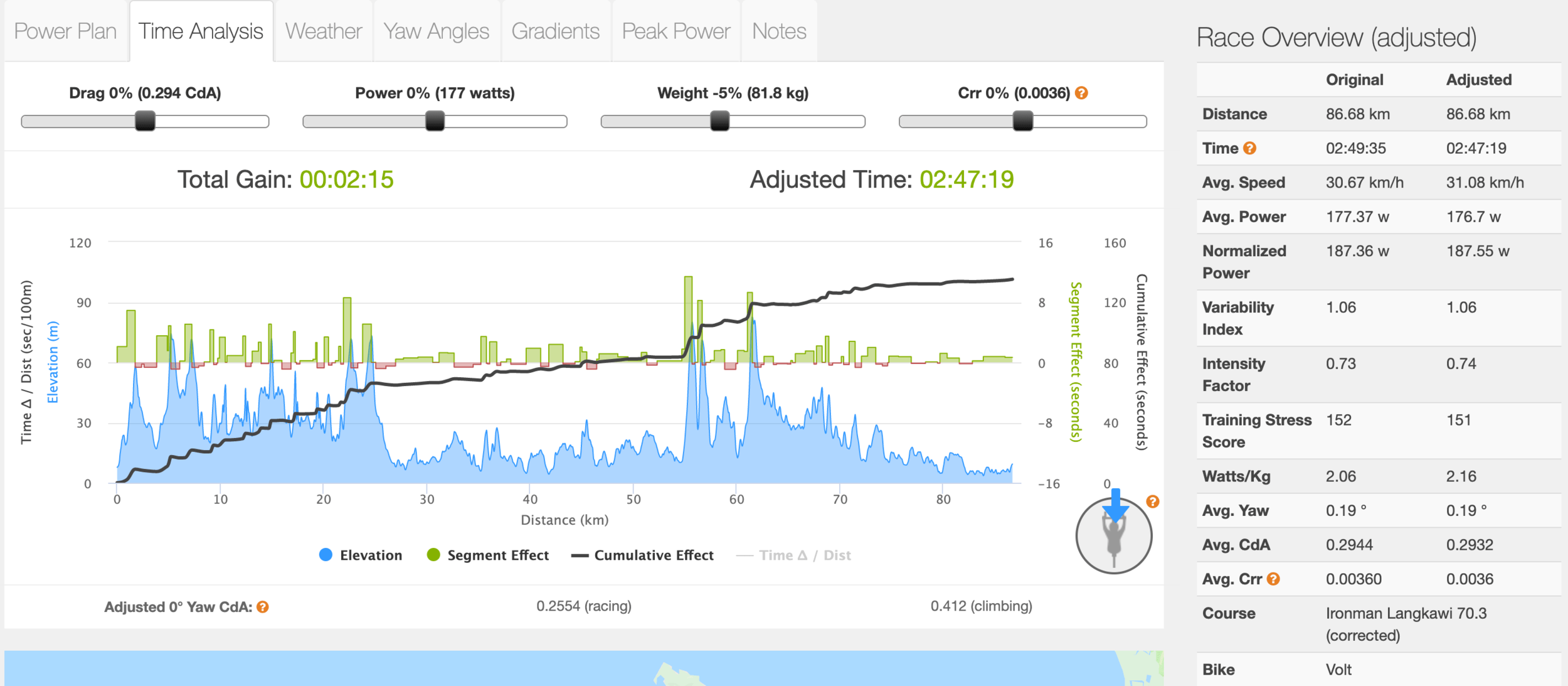Ironman Langkawi 70.3 - how to perform your best time: Case Study.
Langkawi Ironman bike course
Ironman Langkawi 70.3 is relatively slow IM compared to other courses on the IM calendar. Due to high heat and humidity, it makes for a slow run & bike leg even with what we could consider a flat IM bike leg.
The subject of this case study will be my athlete, Ingars, who ware working with Train2Win Endurance Coaching about 7 months at that time. His goal was to finish his first half Ironman under 6 hours.
He is an excellent bike rider; therefore, we considered this to be his strength. Although he could have even better bike split we decided to take it relatively conservatively because of the run. Same as the bike leg run is slow, so conserving strength on the bike would be more beneficial in his case.
“He is an excellent bike rider; therefore, we considered this to be his strength.”
Ingars after finishing another great Ironman
STRENGTH AND WEAKNESSES
During training, we worked a lot on his aerobic capacity and economy. This is one of the most critical metrics in preparing for any long-distance IM.
We've used Best Bike Split software for race time and pace prediction, which gave us the initial insight on what we should prepare for. Using BBS Race Analytics, we ware able to estimate Ingars CdA (Coefficient of Drag which is multiplied by Area) quite accurately, which made race prediction much more precise.
Ingars is riding a road bike with clip-on bars, so bearing this in mind his CdA of 0.28 is a great number for this setup.
At the time of the race, Ingars FTP (Functional Threshold Power) was 258w, and his weight was 86kg, and height 189cm. For those body characteristics racing in such a hot and humid environment is a tough ask. So we did plan to make bike leg relatively easy, negotiating bike course with only IF (Intensity Factor) of 0.73 which would leave plenty of strength to finish the race with a strong run. His goal for Langkawi Triathlon was to finish under 6 hours (spoiler alert – hi finished in 05:42:47).
PREDICTIONS USING BEST BIKE SPLIT SOFTWARE
Using the numbers, we knew from his training and testing, we created initial BBS race prediction:
To see the power of data prediction, we should look into numbers from the actual race from TrainingPeaks software:
Our initial time prediction was off by only 4 and a half minutes, which is quite reasonable, given that it was his first half IM. Time and power difference was due to higher VI (Variability Index) which in turn increased NP (Normalized Power) leaving average power about the same as we initially predicted.
Taking into account that Langkawi Ironman course is quite flat with the only short climb in it, race should be done at VI closer to 1.0, which yields faster race time. If we would adjust the BBS model to same NP but VI closer to 1.0 total time would be significantly faster with almost the same numbers. That is 6 minutes faster than the previous BBS model and 11 (!!!) minutes faster than his actual finish time.
BE THE FIRST
An online coach can help you with your goals
WHAT WE CAN LEARN ABOUT RIGHT RACE PACING?
This shows just how important it is to have a good "throttle control" over one's power output in IM distances.
If we adjust the BBS model to take into account higher VI, this will give an almost precise estimation of race finish time with a deviation of only 3 minutes. As can be seen, BBS is not matching NP even when IF and VI is almost identical. This is due to the inconsistent racing position of an athlete, which cause an increase in CdA during the race. Therefore it demonstrates the importance of practicing your race position on the bike in training so the athlete can be consistent with his or her position on the race day.
“This shows just how important it is to have a good “throttle control” over one’s power output in IM distances”
ROAD BIKE VS TRIATHLON BIKE
This is a question I often hear from my athletes. What bike should I take, what helmet should I use? Do I use deep dish rear-wheel or disc wheel? Using BBS, we can make an estimate using various parameters and find out potential time gain or loss. In this case, specific TRI bike would be about 4 minutes faster than athletes current bike using BBS simulation, given the same all other parameters. So this is what we can call a free speed at least in some sense of this.
HOW TO SIGNIFICANTLY IMPROVE TRIATHLON BIKE SPLIT?
When a triathlon coach uses BBS for race predictions, he usually looks at what are the parameters that make the most significant difference in the outcome. It usually is done 12 to 6 months before the race, so we have plenty of time to prepare the athlete for a good result. Four parameters will change one's race outcome – drag or CdA, power output, riders weights (although we cannot forget the weight of the bike) and coefficient of rolling resistance.
Example of using clip-on tribars
Let's start with drag. In order of importance, drag is affected by:
Position on your bike (aerobars/tribars)
Tri-suit or skinsuit
Aero helmet
Deep section front wheel
Deep section / disk rear wheel
Aerodynamic frame
Shoe covers
Trip socks
This will help you to choose the right investment, next time you are thinking of getting new bling for your bike.
Working on any of those things you could save a lot of time on the course, but for all intents and purposes, I will use a 5% decrease in all four components. Decreasing drag by 5% will get to the finish line by a bit more than 2 minutes faster. This usually would give more significant benefit, but as his CdA is already pretty good, it's lower than usual.
INCREASING POWER = MORE SPEED
This is the main component of your speed. Therefore when working with athletes, this usually is the main focus of training – to be able to produce more power over a given period. If he became only 5% more powerful, this would lead to much faster finish time, cutting it by 4 minutes and 20 seconds. This is just a little bit slower if he would use TRI specific bike which would cost upwards of 12 000$. So investing in your body first always comes first!
DECREASING POWER - SOUNDS EASY, BUT IT`S NOT!
As all endurance sports, triathlon is no exception – you should be able to produce the most significant power at the lowest weight possible. Sounds easy, but it's really not! Dropping weight sometimes goes together with a decrease of power and increase the risk of injury and potential health risks if it's done at significant training load. Even if we could do it slowly and keep the same power, it would save our athlete 2 minutes and 15 seconds on this course. As this is "high-risk investment," I would rely only on 1-2% weight decrease over 2-4 months.
DECREASING ROLLING RESISTANCE
In simple terms rolling resistance is friction between your tires and road surface. So part your watts you'll spend on overcoming resistance form tires and other mechanical parts on your bike. Unfortunately, the overall weight of the system (bike + rider) comes into play, and it closely correlates with Crr. The lower the weight, the lower Crr. Same as reducing drag, to cut down your rolling resistance will take some amount of your hard-earned cash.
You can decrease your rolling resistance by:
Investing in right tires that have low Crr
Investing in latex inner tubes if you ride clinchers
Adjusting air pressure according to road conditions (it's more important than you think!)
Keeping your drivetrain clean
Using low friction wax-based lubricants
Using ceramic bearings
Investing in oversized pulleys
Optimizing your chain line by choosing correct front chainring & cassette combo
Coach would usually call these marginal gains, although getting a good set of tires and matching your tire pressure is a relatively low-cost investment.
So by doing some of these things, you could save almost one and a half minutes on Half Ironman. Not bad if you consider that the majority of the time would come only from tires and air pressure in them!
THE TAKEAWAY
Race body position must be practiced often and on a regular basis
Incorporating longer intervals at or close to race pace keeping VI of 1.0
Increasing overall power is the main focus of training
Keeping your bike clean and adjusted according to race conditions will make you faster
Author,
JANIS MUSINS
Train2Win Endurance Coaching Head Coach
Find out more about Train2Win Endurance Coaching














